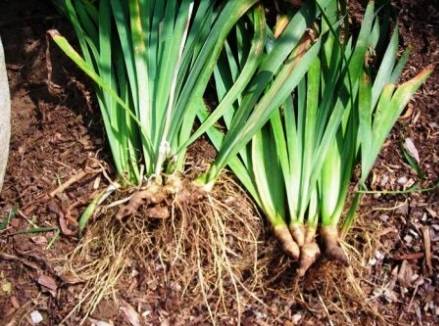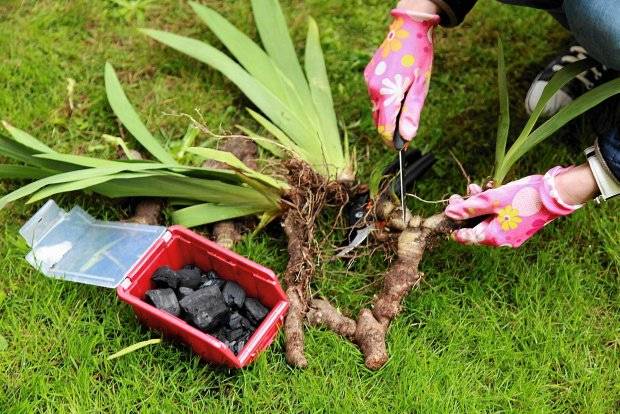Content
The days when irises were randomly planted throughout the garden in small piles or flower beds are long gone. Now some flower growers are not only trying to grow as many varieties of these flowers as possible, but also carefully planning their site in accordance with the flowering time, plant height, and care rules. All these factors are taken into account when creating a variety of flower arrangements, alpine slides and landscape decoration. Iris is perfect for this purpose. This is probably why it is often chosen as a component for decorating spring and summer flower beds and flower beds. And for good reason. Despite the fact that it blooms for a short time, unlike many flowers of its unusual shape, the leaves perfectly retain their green, rich color until autumn. Timely transplanting of irises in the fall is the key to beautifully decorated flower beds.
Another advantage of these garden flowers is their wide range of colors, from snow-white to dark brown. Their aroma is also varied: from delicate caramel with vanilla to chocolate. And despite the ease of care of this flower, irises still need to be replanted.Moreover, replanting irises in the fall is the most prosperous period.
Why is it necessary to replant irises in the fall?
Flower growers have different opinions regarding the timing of transplanting irises. Some people advise planting plants in the spring, others prefer to do this in the summer. More experienced flower lovers advocate replanting irises in the fall. And they support their beliefs with reasoned arguments.
- When planting in early fall, you give them the necessary time to take root. When transplanting in the spring, you deprive them of this time, which immediately affects flowering.
- With the arrival of spring, insects become active and actively reproduce. Many of them can cause irreparable harm to newly planted flowers. After all, immediately after transplantation, irises are most vulnerable. And in the fall the number of pests decreases significantly. Therefore, plants are also at less risk.
- There is a lot of hassle in the garden with the onset of spring. Transplanting irises in the fall will free up your precious time. It is important to choose the right time to plant irises without haste. And with the onset of warm spring days, you will only admire your favorite flowers.
Features of the growing season of irises
Annual replanting of irises in the fall is not required, but once every 3-4 years it is necessary to replant the plant to rid it of old roots. New roots will quickly grow. Without replanting, they stop blooming wildly already in the 5th year. This is especially important for varietal flowers.
Irises bloom from the second half of May to the end of June, depending on the variety and regional affiliation. But with the end of flowering, their growing season does not end.
The growing season of irises throughout the year is divided into several stages:
- With the onset of spring, as soon as the snow melts, they rapidly increase the above-ground part of the plant. Judge for yourself, in just a month and a half, from the first shoots they turn into lush green bushes and the first buds appear on them. It is for this reason that many gardeners advise against replanting irises in the spring. Indeed, for rapid growth during this period, they need a well-rooted underground part of the plant. It is preferable to plant irises in the fall.
- At the end of the flowering phase in early July, active development of the root system begins. During this period, new links are formed, on which young buds will appear by autumn. These are the ones that will bloom next spring. Therefore, if you decide to transplant irises, it is important to catch the moment when new links have grown, but there are no buds yet. Summer transplantation of irises is dangerous because the newly formed tender buds can be easily damaged. Despite numerous advice, it is still not worth replanting until mid-August.
- By the second half of August, the root system of irises ends the phase of active development. The young buds formed on the links have become stronger and are clearly visible to the naked eye. This factor is of no small importance when dividing a large bush into several small ones. From now until mid-October is the ideal time to replant and plant irises in the fall.
It's no secret that irises bloom magnificently if ideal conditions are created for them and the root system is well developed. Since the flowering period begins at the end of spring, it is quite natural that they need to create such conditions in the fall so that by this time the roots are stronger and well rooted.
If you decide to replant irises in the spring, then most of the plant’s time and energy will be spent on strengthening and rooting the root system. There is no point in waiting for flowers this year.
If you follow the timing and rules for transplanting irises in the fall, in one season a bush will grow from a small seedling, which next year will produce good links that can be subsequently planted.
Some features of irises
Knowing some of the preferences of these plants, you will see that growing them is not at all difficult.
- Irises are very demanding regarding such indicators as soil moisture. Therefore, too frequent watering or groundwater located close to the surface can cause root rot. To prevent this from happening, flower growers advise raising the planting bed 10-15 cm above ground level.
- Irises do not like too frequent watering: it is enough to water them 2 - 3 times a week in dry weather. The rest of the time, you need to focus on the condition of the soil at the base of the above-ground part of the plant. If the soil is dry, then the flowers require moisture. And if the soil is moist and soft, then watering is not required.
- The roots are always located closer to the surface of the earth. This feature must be taken into account when planting and caring for irises. Weeds must be removed manually in a timely manner. Using a hoe or flat cutter can damage the roots.
You can learn when and how to replant irises correctly from the following video:
Preparing the soil for replanting
Before you start replanting irises in the fall, you need to choose the right place for the future flower garden.The composition of the soil, groundwater, and lighting greatly influence even such picky flowers.
Irises love sunlight very much. Especially in the first half of the day, the flowerbed should receive the maximum amount of sun. Remember where in your area the snow melts fastest in the spring. This is where irises should be planted in the fall. This will be the perfect place for an iris paradise.
It is advisable that strong winds also avoid the place for transplanting irises.
Unlike other garden flowers, irises love loamy, slightly acidic soil. If the soil is too dense and heavy, sand should be spread over the surface before digging. If the soil is light and sandy, then add a little clay. You can add a small amount of well-rotted humus and ash to the soil, provided that the soil is too acidic. It will be useful to add potassium fertilizers and superphosphates to the soil before transplanting irises in the fall.
It is not recommended to add growth stimulants to the soil when transplanting irises in autumn or spring. In the fall, they will not allow the roots to fully prepare for the onset of winter. And in the spring, the root system, having given all its strength to the leaves, will become weak and defenseless.
It is advisable to complete all preparatory work approximately 7–10 days before the start of transplanting irises in the fall. In order for the soil to compact and take on the desired consistency, the area intended for planting needs to be watered generously 3–4 times. During this period, the loosened and fertilized soil will compact and settle. Now you can plant irises in the prepared area.
Preparation of planting material
When planning planting work, flower growers focus not only on such factors as the time of year. The main signal when it is necessary to replant irises in the fall so that they can better take root and take root is the condition of the foliage. As soon as the tops of the leaves begin to turn yellow, you must immediately begin replanting.
An iris bush in need of emergency replanting should preferably not be watered or fertilized 2–3 weeks before planting. It is necessary to remove the rhizome from the soil only with a pitchfork and with great care. To do this, stepping back 20–25 cm from the base, you must first dig around the perimeter of the iris. And then carefully remove the roots from the ground. After shaking off the remaining soil, dry the planting material thoroughly. After drying, you can begin to divide the main iris bush into small sections.
At this stage, it is important to know how to properly separate small cuttings. It is highly undesirable to divide the bush for subsequent planting manually, without special tools. So, you can not only incorrectly break the roots into links, but also damage most of the young buds. All seed material will be hopelessly damaged and unusable. The separation must be done with a sharp, clean knife. When cutting, it is important to pay attention that on each separated root there is at least one “fan”, several young buds and a piece of root up to 10 cm long. The cut site should be immediately treated with ash, thus carrying out a kind of disinfection.
Too long lateral roots of irises need to be trimmed. Their length should be from 5 to 10 cm.Longer absorbent roots will interfere with replanting irises.
Before planting seed in the prepared soil in the fall, it should be treated with potassium permanganate (light pink solution) or a fugicide. The roots are kept in potassium permanganate for about 20 - 30 minutes, in a disinfecting solution - according to the instructions on the package.
Iris leaves should be cut by 2/3. The shape of the cut should resemble the roof of a house. It is not advisable to completely cut off the leaves, since photosynthesis continues in them until frost. Irises of different varieties should be marked or labeled.
Transplanting irises in autumn
The process of planting irises in the fall is very simple and consists of only three stages. The main thing is to have the desire and a small area of prepared soil. It is advisable to plant flowers in dry weather.
- The planting hole for irises should not exceed 10-12 cm in depth. In the middle of the recess you need to form a small mound, 2-3 cm high.
- The trimmed section is placed on it. It is important that the absorbent roots seem to go down the mound to the bottom of the planting hole. Gently straighten out all the roots. Don't let them bend.
- And lastly, cover the roots with soil. Please note that when watering, the soil will settle by 1-2 cm. The root collar and a small part of the main root after shrinkage should be located above the ground surface.
Autumn work on replanting irises ends as usual - with moderate watering.
As you can see, there is nothing complicated about replanting irises in the fall.The main thing is to monitor the plants for two weeks after planting. Each planted section should stand strictly vertically, not leaning to the side.
The distance between planted flowers can vary from 10 cm to 35 cm. Why is there such a difference? When determining the distance you need, you need to consider:
- Plant variety.
- Height of flowers. Low-growing varieties can be planted closer to each other, tall ones - as far as possible.
- Frequency of transfers. If replanting irises is not part of your plans within 3 to 5 years, then it is advisable to increase the distance between the divisions.
The author of the video will tell you about the basic rules for planting and caring for irises for beginning gardeners:
Caring for irises after autumn planting
Provided that the autumn turns out to be warm and does not indulge in heavy rains, the planted irises should be watered after three to four days.
Caring for irises after planting in early autumn involves timely weeding. It is important to consider that the roots are shallow, and in order not to touch them, it is better to remove the weeds manually.
After transplanting irises in the fall, it is important to monitor the decreasing air temperature. When frost approaches, it is advisable to mulch them with dry leaves, peat or spruce branches. In the Siberian region, mulching is mandatory. At the first opportunity, as soon as the snow melts and there is no threat of severe morning frosts, the mulch layer must be removed. No more care is required for irises in the fall after transplantation. Mother Nature will do the rest. The first spring rays will warm the roots and soon the first green arrows will appear on your site.
If you follow simple planting and care rules, irises gain color in the spring. During the summer, they build up an excellent root system. But you can divide and plant the root only in the second year after planting.
Despite the fact that irises are easy to care for, they should still be replanted every 3-5 years. This way you will protect them from degeneration of varietal characteristics. Moreover, adherence to planting dates will allow you to maintain the root system in excellent condition. And thanks to it, at the end of spring, irises will delight you with lush blooms and a delicate aroma.
Conclusion
As you can see, caring for irises in the fall is not at all difficult. Perhaps it is for this reason that they can often be found in flower beds near kindergartens and schools. After all, we often associate blooming irises with the last bell and the beginning of the summer holidays.


























